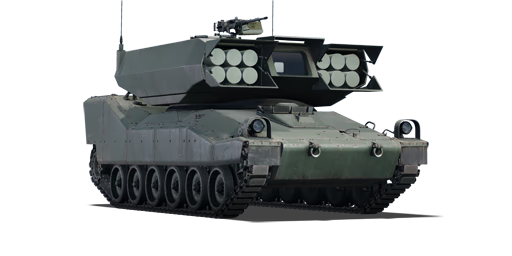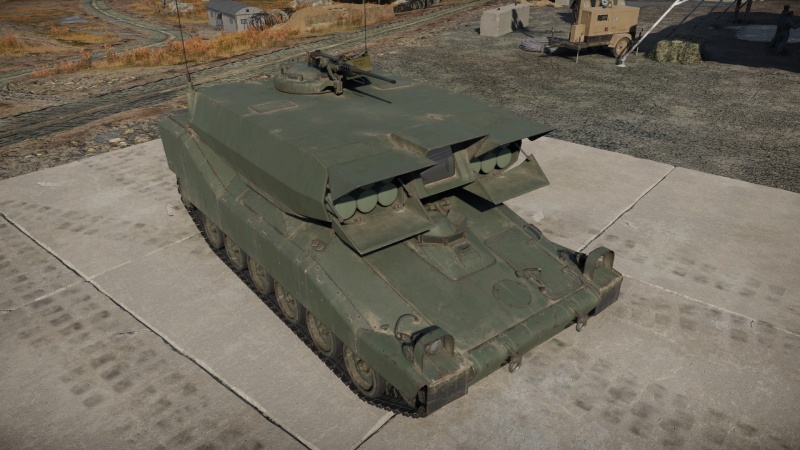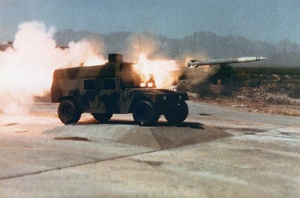Difference between revisions of "LOSAT"
(Added a detailed history section, image of the system in use, and used multiple sources to compile a concise histroy of the LOSAT system.) (Tag: Visual edit) |
(→History) |
||
| Line 110: | Line 110: | ||
<!-- ''Summarise and briefly evaluate the vehicle in terms of its characteristics and combat effectiveness. Mark its pros and cons in a bulleted list. Try not to use more than 6 points for each of the characteristics. Avoid using categorical definitions such as "bad", "good" and the like - use substitutions with softer forms such as "inadequate" and "effective".'' --> | <!-- ''Summarise and briefly evaluate the vehicle in terms of its characteristics and combat effectiveness. Mark its pros and cons in a bulleted list. Try not to use more than 6 points for each of the characteristics. Avoid using categorical definitions such as "bad", "good" and the like - use substitutions with softer forms such as "inadequate" and "effective".'' --> | ||
| − | '''Pros:''' | + | '''Pros:''' |
* MGM-166s are kinetic penetrators and not reliant on HEAT charges, which can make it avoid most ATGM ERAs | * MGM-166s are kinetic penetrators and not reliant on HEAT charges, which can make it avoid most ATGM ERAs | ||
| Line 127: | Line 127: | ||
== History == | == History == | ||
| − | The LOSAT | + | <!-- ''Describe the history of the creation and combat usage of the vehicle in more detail than in the introduction. If the historical reference turns out to be too long, take it to a separate article, taking a link to the article about the vehicle and adding a block "/History" (example: <nowiki>https://wiki.warthunder.com/(Vehicle-name)/History</nowiki>) and add a link to it here using the <code>main</code> template. Be sure to reference text and sources by using <code><nowiki><ref></ref></nowiki></code>, as well as adding them at the end of the article with <code><nowiki><references /></nowiki></code>. This section may also include the vehicle's dev blog entry (if applicable) and the in-game encyclopedia description (under <code><nowiki>=== In-game description ===</nowiki></code>, also if applicable).'' --> |
| + | [[File:HUMVEE Test firing a LOSAT missile at the White Sands Missile Range.jpg|thumb|HUMVEE test-firing a LOSAT missile at the White Sands Missile Range]] | ||
| + | The LOSAT (Line-of-Sight Anti-Tank) system was an evolution of a prior multi-platformed guided missile system design. The concept was initially born out of a US Army requirement for a missile with the capabilities to destroy all types of tanks and armoured vehicles found to be outside of conventional gun range. While other missiles currently in service such as the Tube-launched, Optically tracked, Wire-guided (TOW) system were capable of meeting the range requirements, the Army was concerned that these missiles were ineffective due to slow speeds and long flight times to their target at long range. The missile itself was designed by the "Vought" Aerospace company, while Texas Instruments partnered with the firm by providing their upgraded FLIR system. The initial plan for the system was to mount it to the M2 Bradley, and later the M8 Armored Gun chassis. However, due to cost concerns, it would eventually be mounted onto HUMVEEs with additional missiles carried by trailer. | ||
| − | The | + | The missile's specifications and design made it very different to most ATGM systems of its time. Rather than a dual-warhead, shaped-charge, or HEAT design, it relied on kinetic energy at very high speeds to penetrate the armour of any target it encountered. The design was first test-fired at the White Sands Missile Range in 1990, and orders for the missiles in small numbers were placed after the Army renewed the production contract. Despite this, production did not really begin in any notable numbers until the late 1990s, and only a dozen vehicles paired with 150 missiles were ordered. However, the DOD reduced the program to "Demonstration" status in 1996 and recommended that the program be killed entirely. It was instead re-instated under Lockheed Martin, and the order of missiles and vehicles began to slowly be delivered in 2002, shortly after a second order for 100 more missiles was placed. By this time, it had been nearly 15 years after the initial proposal by Vought. The missiles continued to be test-fired (this time at Fort Bliss) in 2004 before it became obvious to all involved that the project was simply going to be terminated for good. As time had gone on, the Army changed its requirements for the same type of system, preferring to employ a more compact, and lighter missile known as the Compact Kinetic Missile System that had already entered development and could achieve the same results. |
| − | |||
| − | + | == Media == | |
| + | <!-- ''Excellent additions to the article would be video guides, screenshots from the game, and photos.'' --> | ||
| + | ''Excellent additions to the article would be video guides, screenshots from the game, and photos.'' | ||
| − | |||
== See also == | == See also == | ||
<!-- ''Links to the articles on the War Thunder Wiki that you think will be useful for the reader, for example:'' | <!-- ''Links to the articles on the War Thunder Wiki that you think will be useful for the reader, for example:'' | ||
| Line 146: | Line 148: | ||
== External links == | == External links == | ||
| + | <!-- ''Paste links to sources and external resources, such as:'' | ||
| + | * ''topic on the official game forum;'' | ||
| + | * ''other literature.'' --> | ||
* ''Lockheed Martin MGM-166 LOSAT/KEM''. (n.d.). <nowiki>http://www.designation-systems.net/dusrm/m-166.html</nowiki> | * ''Lockheed Martin MGM-166 LOSAT/KEM''. (n.d.). <nowiki>http://www.designation-systems.net/dusrm/m-166.html</nowiki> | ||
Revision as of 10:18, 1 November 2023
Contents
Description
The LOSAT-CCVL is a gift rank VII American tank destroyer with a battle rating of 10.0 (AB/RB/SB). It was introduced during Update "Sons of Attila" as a reward for the 2023 Tokushu Heiki event.
General info
Survivability and armour
Describe armour protection. Note the most well protected and key weak areas. Appreciate the layout of modules as well as the number and location of crew members. Is the level of armour protection sufficient, is the placement of modules helpful for survival in combat? If necessary use a visual template to indicate the most secure and weak zones of the armour.
Armour type:
| Armour | Front (Slope angle) | Sides | Rear | Roof |
|---|---|---|---|---|
| Hull | ___ mm | ___ mm Top ___ mm Bottom |
___ mm | ___ - ___ mm |
| Turret | ___ - ___ mm Turret front ___ mm Gun mantlet |
___ - ___ mm | ___ - ___ mm | ___ - ___ mm |
| Cupola | ___ mm | ___ mm | ___ mm | ___ mm |
Notes:
Mobility
Write about the mobility of the ground vehicle. Estimate the specific power and manoeuvrability, as well as the maximum speed forwards and backwards.
| Game Mode | Max Speed (km/h) | Weight (tons) | Engine power (horsepower) | Power-to-weight ratio (hp/ton) | |||
|---|---|---|---|---|---|---|---|
| Forward | Reverse | Stock | Upgraded | Stock | Upgraded | ||
| Arcade | 75 | 16 | 19.5 | 817 | 1,097 | 41.9 | 56.26 |
| Realistic | 69 | 15 | 509 | 575 | 26.1 | 29.49 | |
Modifications and economy
Armaments
Main armament
| LOSAT/MGM-166A missile | Turret rotation speed (°/s) | Reloading rate (seconds) | |||||||||||
|---|---|---|---|---|---|---|---|---|---|---|---|---|---|
| Mode | Capacity (Belt) | Vertical | Horizontal | Stabilizer | Stock | Upgraded | Full | Expert | Aced | Stock | Full | Expert | Aced |
| Arcade | 12 (12) | - | ±110° | - | __._ | __._ | __._ | __._ | __._ | _.__ | _.__ | _.__ | _.__ |
| Realistic | __._ | __._ | __._ | __._ | __._ | ||||||||
Ammunition
| Penetration statistics | |||||||
|---|---|---|---|---|---|---|---|
| Ammunition | Type of warhead |
Penetration @ 0° Angle of Attack (mm) | |||||
| 10 m | 100 m | 500 m | 1,000 m | 1,500 m | 2,000 m | ||
| MGM-166 | ATGM | 70 | 150 | 443 | 775 | 729 | - |
| Missile details | ||||||||||||
|---|---|---|---|---|---|---|---|---|---|---|---|---|
| Ammunition | Type of warhead |
Velocity (m/s) |
Range (m) |
Projectile mass (kg) |
Fuse delay | Fuse sensitivity (mm) |
Explosive mass (TNT equivalent) (g) |
Ricochet | ||||
| 0% | 50% | 100% | ||||||||||
| MGM-166 | ATGM | 1,520 | 5,000 | 78.92 | - | - | - | 78° | 80° | 81° | ||
Ammo racks
| Full ammo |
1st rack empty |
2nd rack empty |
3rd rack empty |
4th rack empty |
5th rack empty |
6th rack empty |
Visual discrepancy |
|---|---|---|---|---|---|---|---|
| 1 | __ (+__) | __ (+__) | __ (+__) | __ (+__) | __ (+__) | __ (+__) | __ |
Machine guns
| 12.7 mm M2HB | ||||
|---|---|---|---|---|
| Mount | Capacity (Belt) | Fire rate | Vertical | Horizontal |
| Pintle | 1,000 (200) | 575 | -5°/+10° | ±70° |
Usage in battles
Describe the tactics of playing in the vehicle, the features of using vehicles in the team and advice on tactics. Refrain from creating a "guide" - do not impose a single point of view but instead give the reader food for thought. Describe the most dangerous enemies and give recommendations on fighting them. If necessary, note the specifics of the game in different modes (AB, RB, SB).
Pros and cons
Pros:
- MGM-166s are kinetic penetrators and not reliant on HEAT charges, which can make it avoid most ATGM ERAs
- Extremely high penetration values at farther ranges
- 12 missiles are highly effective and enough to deal with targets
- Armour around the missile racks have over 150 mm of armour protection, making it resistant to most non-APFSDS autocannon fire
- Missiles can be too fast for IRCM systems to react
Cons:
- No vertical guidance at all
- The MGM-166s instability can cause inaccuracy when hitting targets, especially when firing from angled surfaces
- Being in close-medium combat can be too short to effectively generate enough velocity to penetrate armour
- Missile drop when firing can cause impact into terrain/objects
- Extremely long ammo replenish length (over a minute in Realistic battles, around 30 seconds in Arcade battles)
History
The LOSAT (Line-of-Sight Anti-Tank) system was an evolution of a prior multi-platformed guided missile system design. The concept was initially born out of a US Army requirement for a missile with the capabilities to destroy all types of tanks and armoured vehicles found to be outside of conventional gun range. While other missiles currently in service such as the Tube-launched, Optically tracked, Wire-guided (TOW) system were capable of meeting the range requirements, the Army was concerned that these missiles were ineffective due to slow speeds and long flight times to their target at long range. The missile itself was designed by the "Vought" Aerospace company, while Texas Instruments partnered with the firm by providing their upgraded FLIR system. The initial plan for the system was to mount it to the M2 Bradley, and later the M8 Armored Gun chassis. However, due to cost concerns, it would eventually be mounted onto HUMVEEs with additional missiles carried by trailer.
The missile's specifications and design made it very different to most ATGM systems of its time. Rather than a dual-warhead, shaped-charge, or HEAT design, it relied on kinetic energy at very high speeds to penetrate the armour of any target it encountered. The design was first test-fired at the White Sands Missile Range in 1990, and orders for the missiles in small numbers were placed after the Army renewed the production contract. Despite this, production did not really begin in any notable numbers until the late 1990s, and only a dozen vehicles paired with 150 missiles were ordered. However, the DOD reduced the program to "Demonstration" status in 1996 and recommended that the program be killed entirely. It was instead re-instated under Lockheed Martin, and the order of missiles and vehicles began to slowly be delivered in 2002, shortly after a second order for 100 more missiles was placed. By this time, it had been nearly 15 years after the initial proposal by Vought. The missiles continued to be test-fired (this time at Fort Bliss) in 2004 before it became obvious to all involved that the project was simply going to be terminated for good. As time had gone on, the Army changed its requirements for the same type of system, preferring to employ a more compact, and lighter missile known as the Compact Kinetic Missile System that had already entered development and could achieve the same results.
Media
Excellent additions to the article would be video guides, screenshots from the game, and photos.
See also
Links to the articles on the War Thunder Wiki that you think will be useful for the reader, for example:
- reference to the series of the vehicles;
- links to approximate analogues of other nations and research trees.
External links
- Lockheed Martin MGM-166 LOSAT/KEM. (n.d.). http://www.designation-systems.net/dusrm/m-166.html
- Wikipedia contributors. (2022, November 5). MGM-166 LOSAT. Wikipedia. https://en.wikipedia.org/wiki/MGM-166_LOSAT
| USA tank destroyers | |
|---|---|
| M10 | M10 GMC |
| M36 | M36 GMC · M36B2 |
| T95 | T28 · T95 |
| M109 | M109A1 |
| ATGM | LOSAT · M901 |
| Wheeled | M3 GMC · T55E1 |
| Other | M8 HMC · M50 · M56 |
| China | ▃LVT(A)(4) (ZIS-2) |






